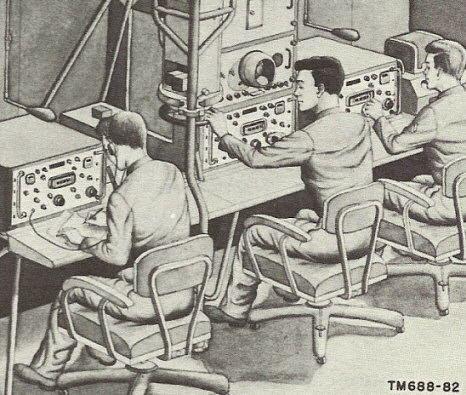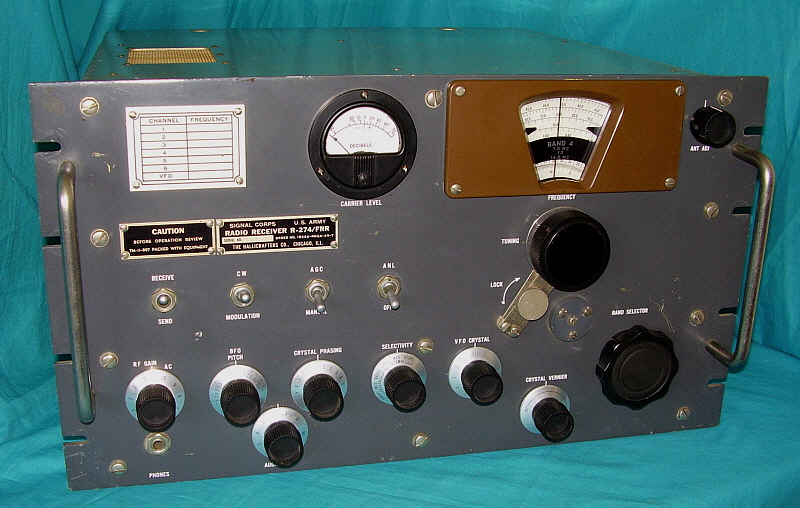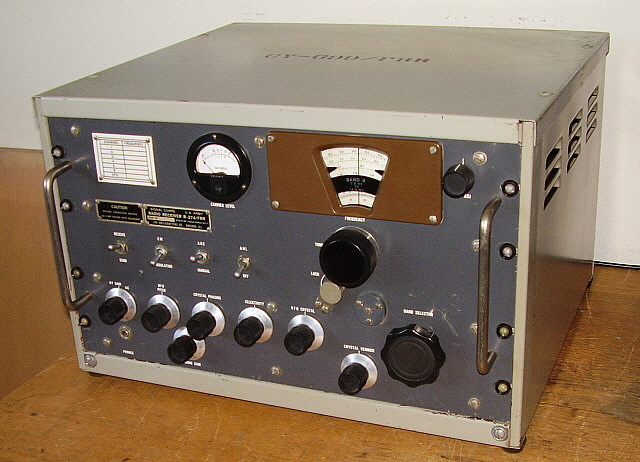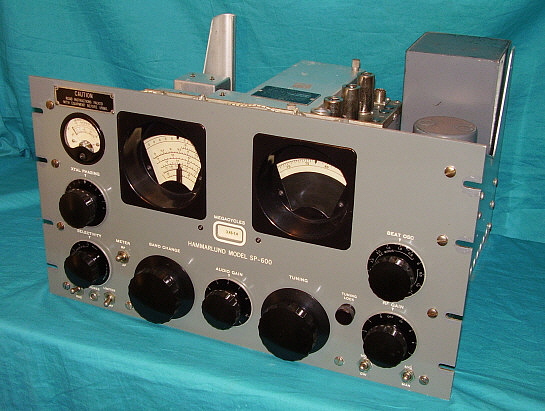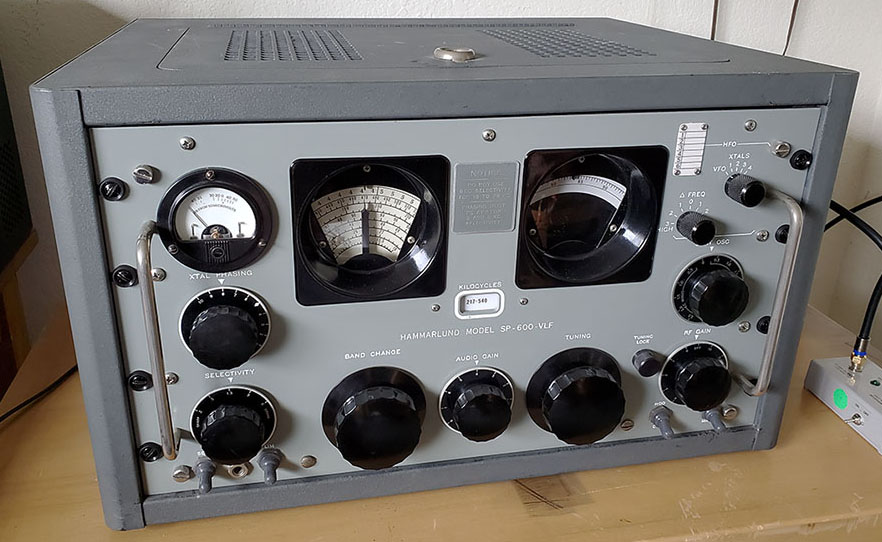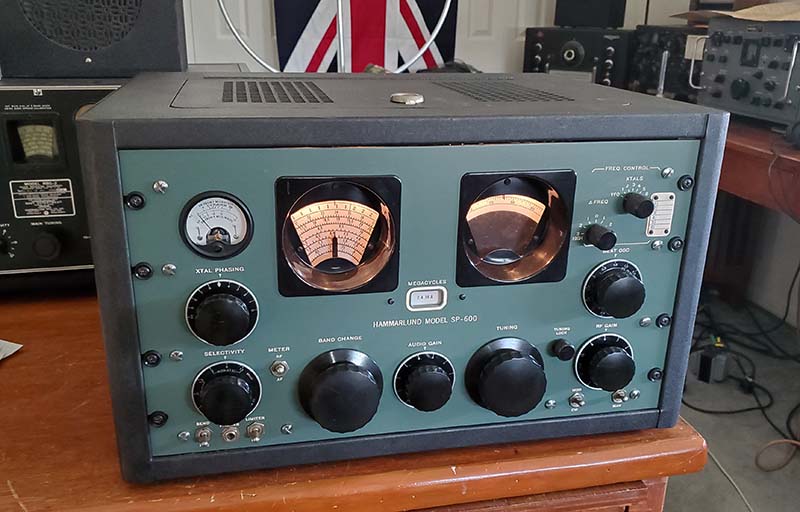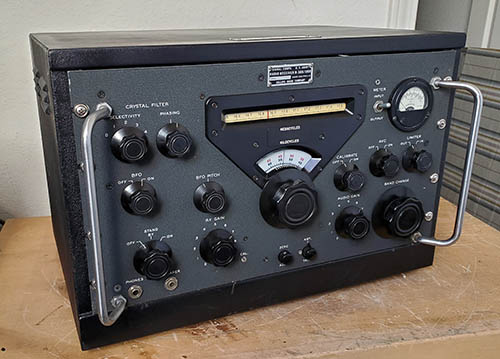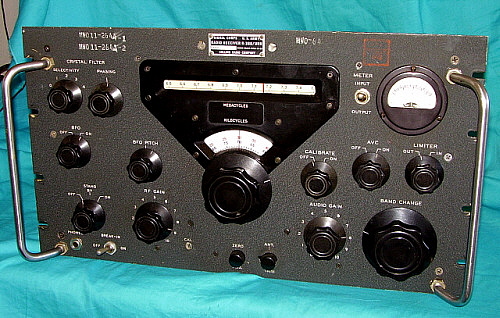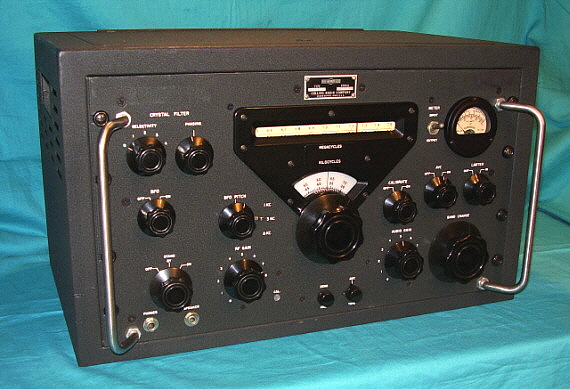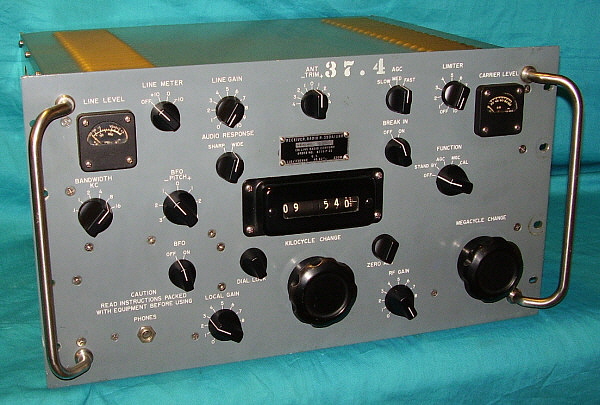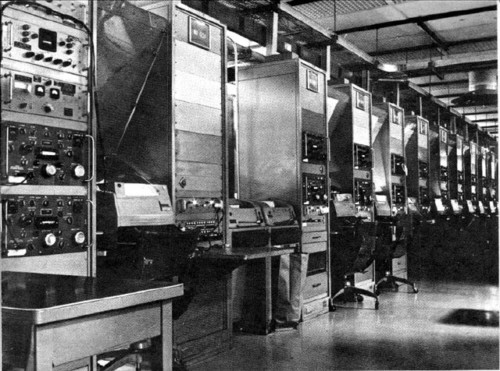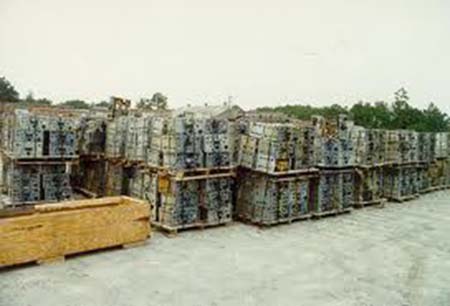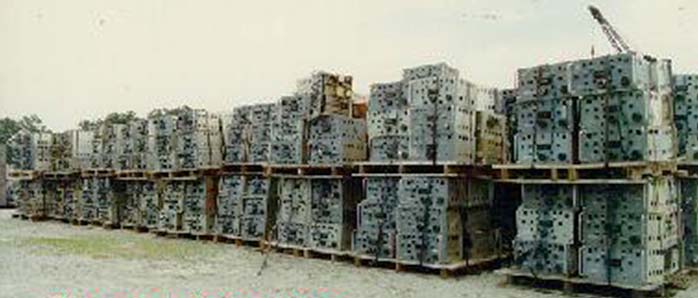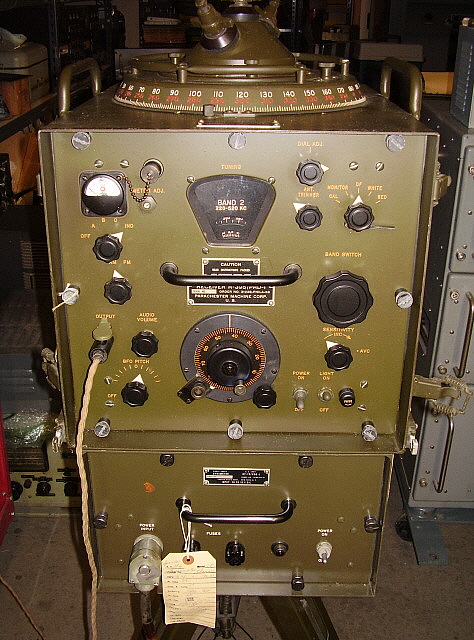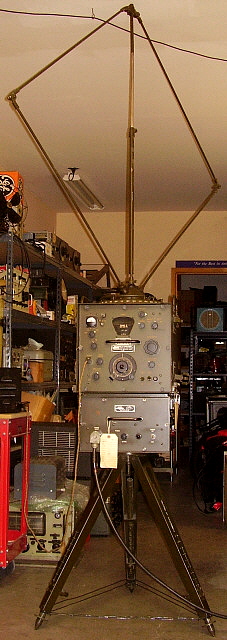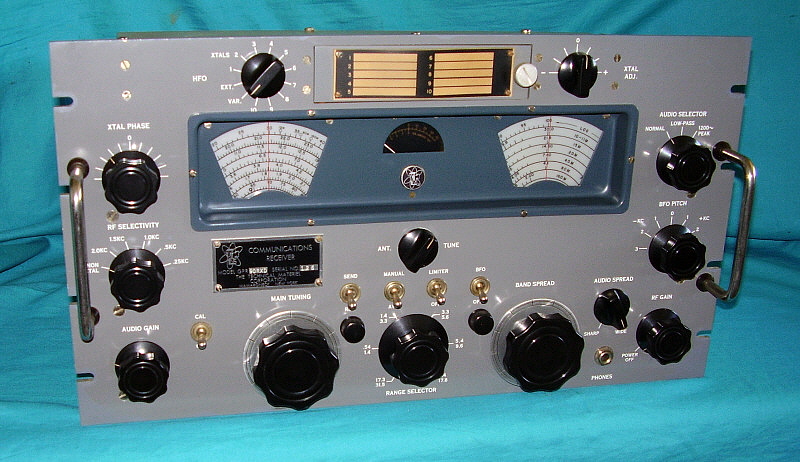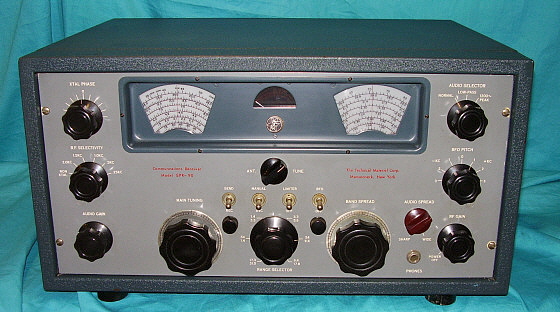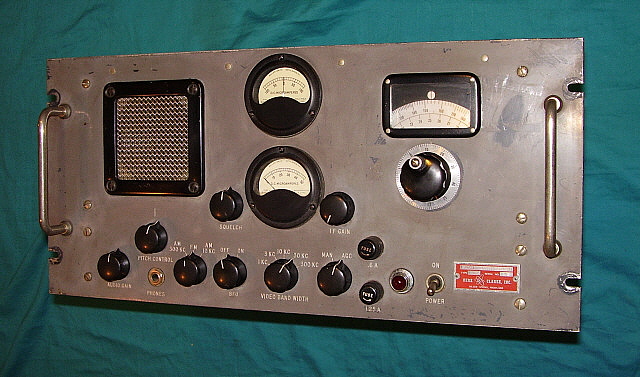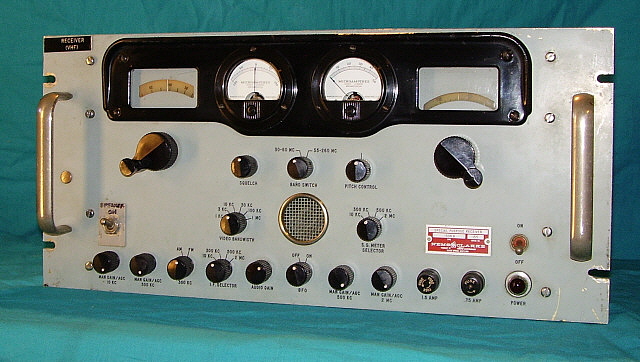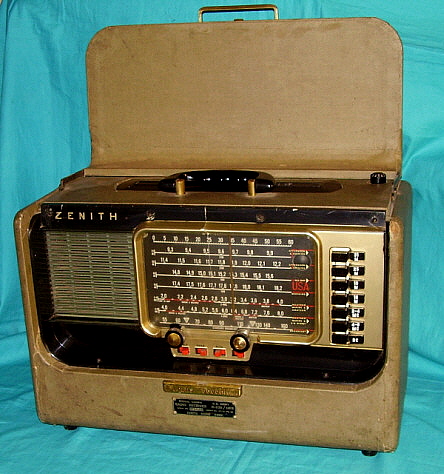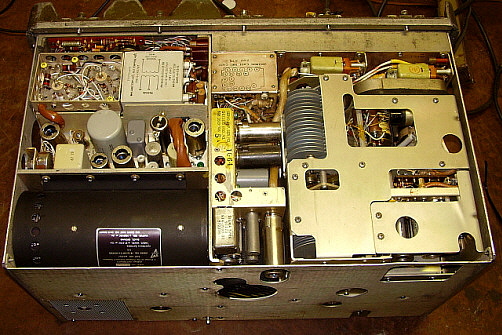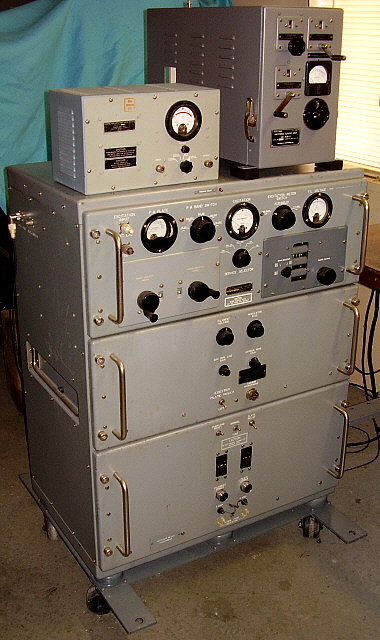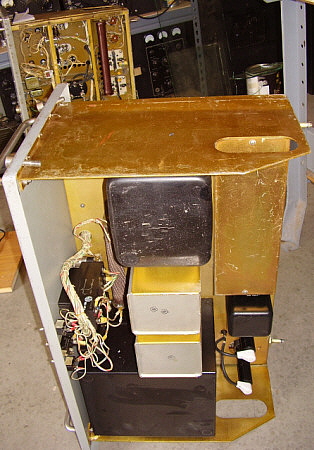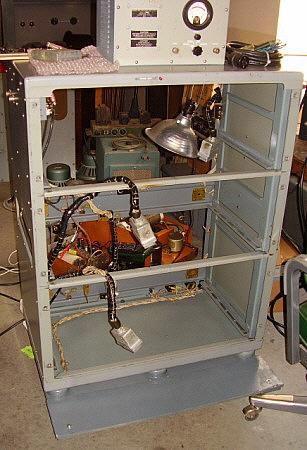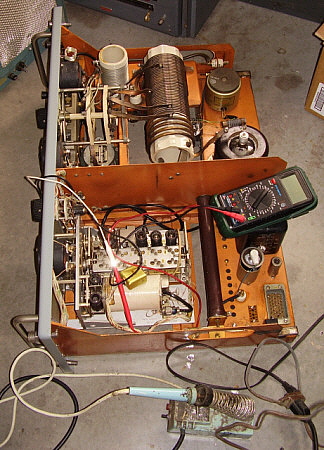|
RACAL
Racal
Engineering Ltd (UK) - Racal Communications, Inc. (USA)
RA-17 Series, RA-17 "C-Series," RA-117 Series, RA-6117
Racal Ltd and Racal
Engineering Ltd was a British company that was founded by Raymond Brown and George
(Jock)
Calder Cunningham in 1950. The company name was derived from the names
of the founders RAy Brown and Geo. CALder Cunningham. Both
Brown and Cunningham had quit their jobs at Plessey to start their
business. When business was slow (often, at first) they would build
things other than electronics, such as golf clubs or shelving units. In
1953, the British Royal Navy wanted Racal to build a couple hundred
Collins 51J receivers for RN use. Racal wanted to use mostly British
parts but Collins insisted that parts from the USA had to used. After an
inspection of the (then) small Racal manufacturing facility, Collins
refused to license the manufacture of the 51J by Racal.
| The Wadley Loop and the RA-17
- Left with
designing their own receiver for the contract, Racal contacted Dr.
Trevor Wadley in South Africa to help with the project. Using a circuit
that Wadley had developed in the 1940s for test equipment (and that Dr.
Wadley was incorporating into a receiver design of his own,) the "Wadley
Loop" was incorporated into the Racal receiver design.
The Wadley Loop virtually eliminated frequency drift by using
a combination of one fixed oscillators, one VFO and three mixer circuits. Note the block diagram
shown to
the right. First, a 1.0mc crystal
oscillator feeds a harmonic generator that produces strong multiple 1mc
harmonics that are used to create thirty selectable 1mc wide tuning
ranges. This "comb" of harmonics are fed into Mixer 4 and combined with
the output from the MC/VFO which tunes 40.5mc to 69.5mc. Simultaneously,
the RF input signals are fed to Mixer 1 and combined with the output
from the same MC/VFO
output. The output of Mixer 1 tunes from 39.35mc to 40.65mc and feeds
Mixer 2. Also simultaneously, the output of Mixer 4 goes to a 37.5mc
amplifier, a bandpass filter and then another 37.5mc amplifier with its
output also connected to Mixer 2. The "drift cancelling" happens
because "Mixer 1 + the MC/VFO" and
"the MC/VFO + Mixer 4" are the inputs to Mixer 2. If there's a
frequency drift of, for example, 2kc in the MC/VFO, that frequency
drift is seen in both Mixer 1 and Mixer 4 outputs (+2kc.) The
Mixer 2 output is the difference of the two inputs (both +2kc)
and still results in the 2-3mc IF. Since the drift is added (or
subtracted) simultaneously to both inputs of Mixer 2, the
resulting output doesn't change since the difference remains the
same, thus the drift is cancelled (f+2 - f+2 = 0 drift.) Tuning the MC/VFO produces a Mixer 2 output that
varies from 2 to 3mc. The KC/VFO tunes from 2.1 to 3.1mc and its output
is combined with the 2 to 3mc 2nd IF in Mixer 3 producing a
fixed 100kc 3rd IF. |
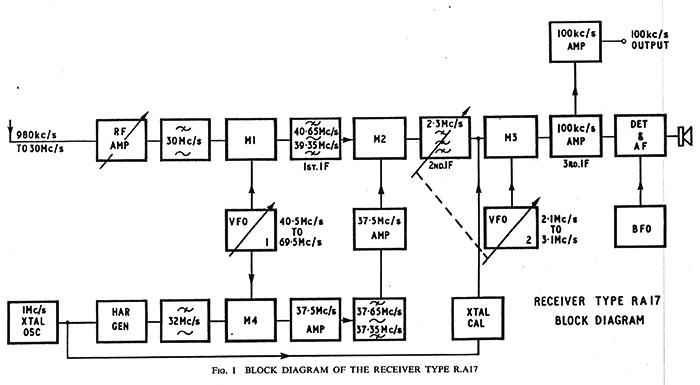 |
Although the Wadley Loop might be the "heart" of the
RA-17, it's the elaborate Antenna-RF preselector circuit that allows the receiver's
performance to be maximized for any frequency or antenna used. The
preselector has a very Hi-Q and has six tuning ranges plus a variable
tuning control. This allows exact tuning of the RF amplifier grid input
which results in the absolute best transfer of antenna energy to the
receiver's front end. A four-step attenuator can be selected if
unusually strong signals are encountered. Racal's first receiver was
designated the RA-17 and it was the first successful receiver to employ
the "Wadley Loop" system for oscillator and conversion stability. The
first British Royal Navy RA-17 receivers supposedly cost £ 300 each, an
equivalent cost then of about $1500. The RA-17 was produced from around
1957 up to around 1973. The RA-17 was upgraded several times but also
many variations were produced that were built for special purposes or to
be used with other specific equipment. The RA-17 "C series" was
generally built for North American use and has US-compatible parts.
As the Racal receivers became more and more popular with
commercial and military users, a manufacturing facility was opened in
the USA (one of many around the world) called
Racal Communications, Inc., located in Silver Spring, Maryland. All of the receivers produced
in the USA (or produced in the UK for North America) will have either an
"A," a "C" or "6" (or combinations) added to the standard model number
thus the RA-6117 is the "made in the USA" version of the RA-117 receiver
(the RA-117 was a somewhat different version of the RA-17
that, for the most part, was produced concurrently with the
various types of RA-17 receivers.) Production of the RA-17 and RA-117
runs up to about the mid-1970s at
which time the RA-1217/RA-6217 solid state receiver was also in
production having been introduced around 1967. Racal also
produced many different types of accessory equipment for the RA-17, e.g., VLF/LF/MF converters, digital frequency readouts
using Nixie tube displays, panoramic adapters, SSB adapters, diversity equipment, RTTY
equipment, transmitters and many other devices. At one time, Racal
employed 30,000 workers building many different types of electronics
(not just radio equipment.) It was the third largest electronics firm in
Britain and had facilities in 110 different countries. Calder Cunningham
died in 1958 and, in 1966, Ray Brown accepted a political position in
British Ministry of Defense, retiring from the
company. After 1966, Ernest Harrison was in charge of Racal. The
company also owned Decca, Chubb and Vodafone to name a few of their
holdings. Several reorganizations and division sales occurred in the 1990s and, in 2000,
Thomson-CSF (aka Thalen Group) purchased the bulk of Racal Electronics.
RA-17 Series/RA-17 C-12 aka
AN/URR-501A
- The RA-17 Series receivers comprise many slightly different
versions depending upon the end-users specific requirements. There were
over 40 different versions of the RA-17 built. All RA-17
receivers will have a suffix that further identifies what particular
version the receiver belongs to. The "C- Series" were the North American versions of the RA-17 built in
England but specifically for export. There were over 20 different versions of
the C-Series of RA-17 receivers. Most of the different versions were for
specific uses, such as Broadcast monitoring where the BFO circuit was
eliminated and different IF bandwidths used or changes to allow operation
with specific models of Racal accessories. Some C-12 versions were also
identified as AN/URR-501A using the Army-Navy designation. Most C-Series hardware is UNF
for USA compatibility. All of the tubes are USA types but two were
eliminated, the GZ-34 rectifier tube and V-24 were replaced with
solid-state substitutes. Other minor changes were to the 3.0Z ohm audio
output that was increased to 1 watt. Also, a 10K 10W load was added to the B+
when the receiver was placed in Stand By and standard UHF and BNC
connectors were used for rear-chassis connection auxiliary inputs or
outputs (for accessory devices.) The preselector (panel ID: ANT TUNE) is
actually an elaborate antenna tuning network that essentially provides
a precisely tuned, Hi-Q output that feeds the RF amplifier grid. The preselector
has six tuning ranges and a variable frequency "tuner." This tuned RF input can be bypassed in the
"wideband" position which is then an untuned "wideband" fixed 75Z ohm input. The
Antenna Tuning provides an increase in sensitivity by way of much better
signal transfer to the RF amplifier grid and also the Hi-Q allows for better
selectivity for the incoming signal which
helps with reducing interference from strong, near-frequency, near-field signals. A
five-step attenuator can be inserted into the signal path to reduce the input level to the RF amplifier if
intensely strong signals are encountered. The RF amplifier is a standard
pentode tube in RA-17 receivers but the C-Series used a cascaded
dual-triode tube 6ES8. The
kilocycle tuning dial is a filmstrip type that is six feet long and
spans 1000kc with a resolution of 1kc. When tuning the receiver, the
dial index remains stationary while the numerical dial scale moves
behind the index in a linear fashion. The megacycle dial is circular and
is read thru the lower window of the dial escutcheon. To readout the
tuned frequency one has to add the megacycle dial setting to the
kilocycle dial reading. If the megacycle dial is set to 11 and the
kilocycle dial reads 854 then the tuned frequency is 11.854mc (as shown
in the RA-17 C-12 photo above.) The black kilocycle scale is used while tuning
from 1-30mc while the red kilocycle scale is used when operating with the optional
MW-LF-VLF converter (10kc to 980kc.) The tuning system is super-smooth
and very light feeling. The film strip is easy to read to at least 1kc
accuracy. A 100kc Calibration oscillator is provided to assure frequency
readout accuracy. The RA-17 used 23 tubes but since the GZ-34 rectifier
tube was replaced in the C-series receivers with a solid-state rectifier
the RA-17 C-12 uses 22 tubes. The RA-17 Series tunes from 1.0mc up to
30mc in 30, one megacycle wide tuning ranges. Tuning from .5mc to 1.0mc
is possible but with noticeably diminishing performance as the frequency
is tuned lower within that range.
| The use of triple-conversion and the drift
reduction Wadley Loop provided solid stability. The normal
C-Series bandwidth was selectable from 13kc down to 100hz in six
positions. Last IF operates at 100kc with
rear chassis outputs available. Selectable fast and slow AVC
and a Noise Limiter were provided. A standard diode detector was
used but the BFO injection is sufficient to allow
easy demodulation of SSB signals.
Several types of audio outputs are available at the rear connector
terminals. BNC connectors provide IF output, 1MC output and RF input
(for the LF converter and other compatible accessories.) UK versions only had a two-position
meter function (toggle) switch. The "C" versions had a three-position switch
allowing RF level, S-meter and AF level functions. Most of the RA-17 side
panels have a slope beginning about halfway back and the top
cover also slopes at the rear half of the receiver. The front panel is steel and is the standard 10.5" x 19.0" but
the receiver depth is 20.5" which is considerably deeper than
any USA-made receivers. The panels on the RA-17 receiver were
originally
supposed to be British Admiralty Gray (or battleship gray) but most
encountered seem to be a light greenish
color. Many RA-17 receivers panels were equipped with panel "scuff
protectors" that mounted behind the Kilocycle and Megacycle tuning
dials. These were normally made from clear plexiglass and protected the
panel from "fat finger" syndrome that usually left the paint
worn off in a "ring" around the knobs. The RA-17 C-12 shown above
and right
has opaque black "scuff protectors" installed. Apparently, this
type could be installed if the panel already had "wear-rings"
since they hid any damage and prevented any further damage.
Since these type of protectors aren't transparent the covered
nomenclature is engraved into the white-on-black plastic
material. The MC and KC tuning knobs along with the five
"non-winged" smaller
knobs have a collet-type of grip on the shaft. Knob removal
requires using a hex wrench to loosen the chrome nut at the
center of each knob. These collets shouldn't be over-tightened
when reinstalling these knobs. |
|
|

RA-6117 SN: 193 from 1966 |
RA-117/RA-6117
- The RA-117 was introduced somewhat later than the RA-17 but for the
most part was built
along side that receiver. It's a slightly different receiver than the RA-17 and was
developed to allow more of a variety of auxiliary equipment to be interconnected
and operate with the receiver (such as the MA-79G exciter.) The RA-6117 is a version
of RA-117 built in Silver Spring, Maryland, USA by Racal
Communications, Inc. It's almost identical to the RA-117 but using all standard USA manufactured tubes. Most of the
hardware is also standard US threads and sizes. USA-style knobs are used
on the RA-6117.
Like the RA-17, the antenna preselector circuit can be set to "wide band" which is an
untuned 75Z ohms input or the
six-step frequency ranges can be selected and peaked for maximum
response for the particular frequency and antenna in use. There is also a step-attenuator
provided for coping with very strong signals but still being able to
retain the tuned selectivity that the R.F. TUNE (was ANT TUNE on the
RA-17) provides. The RF amplifier uses a cascaded dual triode tube
(6ES8.) The Wadley Loop front-end was basically unchanged but the RA-117
did add an extra conversion-IF amplifier stage
after the 2-3mc IF bringing the total conversions to four. The four
conversion consisted of a tunable 40.65-39.35mc, a tunable 2-3mc, a fixed 1.6mc and
a fixed 100kc. The additional conversion used a slightly different type KC-VFO (tuned 3.6mc to
4.6mc rather than the 2.1mc to 3.1mc VFO of the RA-17.) The KC-VFO/Mixer
operated into a fixed
1.6kc IF which was then converted (crystal oscillator/mixer) to a fixed 100kc IF.
The 3.6-4.6mc KC-VFO also featured external input and outputs to allow
the RA-117 tuning to control (or be controlled) by other devices. VFO
selector switch is on the front panel next to the Kilocycle tuning knob.
IF bandwidths from 13kc to 100hz, Fast and Slow AVC,
three position switch allows the meter to act as an RF signal level, AF
level or S-meter, standard envelop detector - no product detector are
features provided. Several BNC inputs/outputs are provided for
External VFO, various Oscillator Outputs, 100kc IF Output along with
terminals for several 600Z ohm outputs and a 1W 3.0Z ohm output.
|
| A separate audio output (600Z ohm) with an Audio Level
control on the front panel that has its own output transformer
and operates separate from the standard receiver audio output.
This output was for driving a data device, an audio input RTTY
converter, for example. The small built-in speaker can be switched off
if a larger speaker is desired (connecting to the 1W 3.0Z ohm output
works best.) RA-117 receivers use 25 tubes. RA-117 Series tunes 1-30mc in 30 bands. Also, .5-1mc tuning with
noticeably diminished performance as one tunes lower in frequency within
this range. The RA-6117 front panel color is usually cream color with
black nomenclature. Scuff protectors aren't usually found on RA-117 receivers as the EXT/INT
VFO switch interferes with proper positioning. Although the RA-17 and
RA-117 panels are standard 10.5" x 19.0" the receiver's chassis
is quite deep at 20.5" which, of course, won't fit into any
standard American cabinets. There were cabinets available that
were specifically for the RA-17/RA-117 and only increase the
overall receiver foot-print an inch or two. Other after-market
general purpose cabinets that have the necessary depth are
usually very large and increase the overall receiver size
substantially. However, most receivers usually will have their
dust covers and, like the R-390A, look quite nice setting on a
table "sans cabinet." |
Performance
RA-17 and RA-(6)117 - With either the RA-17 or the RA-(6)117,
sensitivity is first rate as these receivers can "hear" just
about anything that's being transmitted, depending on
the listener's location and receiving conditions. Best reception results will require a
good, resonant frequency or "tuned" antenna system and very
careful tuning of the RF antenna preselector. This circuit
is very Hi-Q and the tuned "peak" is very sharp. The signal gain
with precise grid input tuning to the RF amplifier is
impressive. "Wideband" can be used with strong, near-field
signals, like AM BC stations. The Attenuator can be used to
quickly reduce strong signals while still keeping the preselector tuned. The filmstrip dial is easy to
read and is accurate "to the kilocycle" if the CAL oscillator is used. IF
Bandwidth selections will usually be 3kc or 6kc for normal
listening. SWBC stations sound fine on 6kc and if they are
particularly strong and transmitting something interesting the
13kc bandwidth provides excellent reproduction. The 13kc could be
used on AMBC in the 1000kc to 1700kc part of the band if there
was something worth listening to.
Performance below 1000kc is okay for about 100kc or so, then it
begins to degrade. The bandwidths of 1.2kc, 500kc and 100kc can
be used for CW signals. For reducing adjacent frequency SSB
signals while in the AM mode, "off frequency tuning" is the
easiest and most effective defense. Speaking of SSB, the BFO coupling is via a
45pf capacitor but that
provides sufficient injection for excellent SSB demodulation. In
some cases, the RF/IF Gain might have to be reduced to clear up
distortion on particularly strong SSB signals but most average
strength SSB signals demodulate fine with the IF/RF Gain fully
advanced and the AVC on. Upper and lower sideband can be selected by
using the +/- BFO setting (which is like
the R-390A.) Use + BFO settings for LSB and - BFO settings for
USB. There are three low power 600Z outputs for driving data
devices. For the best audio reproduction use a good quality
external speaker connected to the 3.0Z ohm output. The 3Z ohm
Audio Output is 1 watt on the "C" versions and provides more than adequate drive. Shortwave BC
stations and AMBC stations that are transmitting quality
programming will sound
incredible. There are slight differences between the British
RA-17 receivers and those RA-17C receivers built in England for
the USA or NATO. Also, there are some differences between the
RA-17 Mark III versions and the earlier Mark II receivers.
Performance for all versions is nearly identical although
bandwidths, audio power, BFO tuning, meter functions and other
minor variations will be encountered with the different
receivers.
For more details on RACAL receivers, company
history, details on the RA-237-B LF Converter, details on the
RA-6217E Solid State receiver go to "RACAL - British High
Performance Receivers" use "Home/Index" for navigation. |

RA-17L Mark III in original military RACAL table cabinet from 1964
The plastic "scuff protectors" were to prevent
"fat finger syndrome." That happened when the operator's fingers
gripped the tuning knob, overlapping the entire grip-area of the
knob and rubbed the finger tips against the front panel. Over
time, this would wear the paint off of the front panel
(usually a circular ring of missing paint surrounding the tuning
knobs.) The black "scuff protectors" on the RA-17C-12 were
installed to hide "fat finger damage." |
|
